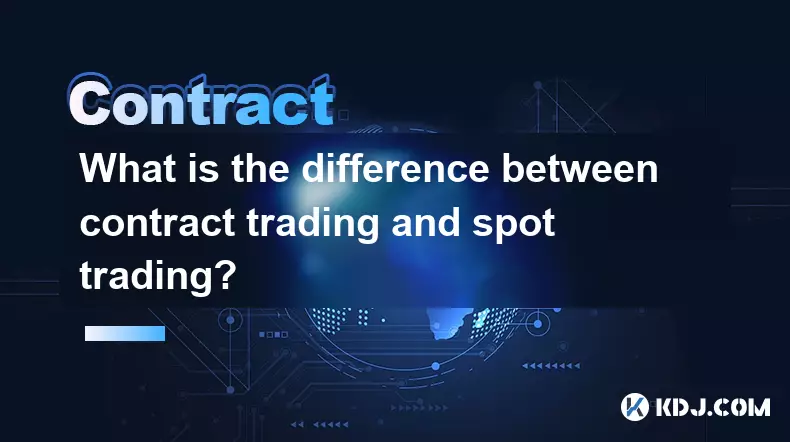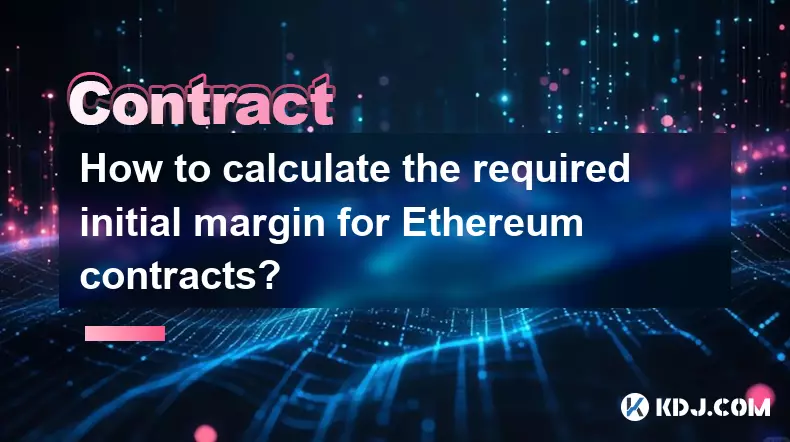-
 bitcoin
bitcoin $120167.907534 USD
1.27% -
 ethereum
ethereum $4468.611945 USD
2.53% -
 xrp
xrp $3.013607 USD
1.80% -
 tether
tether $1.000549 USD
-0.01% -
 bnb
bnb $1092.592149 USD
6.28% -
 solana
solana $231.391244 USD
4.59% -
 usd-coin
usd-coin $0.999699 USD
-0.04% -
 dogecoin
dogecoin $0.259020 USD
4.30% -
 tron
tron $0.342747 USD
0.34% -
 cardano
cardano $0.860977 USD
1.07% -
 hyperliquid
hyperliquid $50.155412 USD
5.34% -
 chainlink
chainlink $22.637678 USD
0.46% -
 ethena-usde
ethena-usde $1.000528 USD
-0.07% -
 avalanche
avalanche $30.613779 USD
-0.07% -
 stellar
stellar $0.403905 USD
0.94%
What is the difference between contract trading and spot trading?
Spot trading offers direct ownership of crypto assets with lower risk, while contract trading provides leveraged exposure and tools for short-term speculation.
Sep 21, 2025 at 07:18 am

Understanding Spot Trading Mechanics
1. Spot trading involves the immediate exchange of cryptocurrencies at the current market price. Transactions settle instantly, and ownership transfers directly to the buyer.
2. Traders acquire actual digital assets that can be transferred, stored in wallets, or used across decentralized platforms. This form of trading emphasizes possession and long-term holding strategies.
3. Liquidity in spot markets typically comes from direct buy and sell orders matched on centralized exchanges. Price volatility is influenced by real-time supply and demand dynamics without leverage amplification.
4. Fees are generally lower compared to contract trading, with most platforms charging a flat rate based on trade volume. There is no expiration or funding rate involved in these transactions.
The primary advantage lies in asset ownership, making spot trading ideal for users focused on accumulation rather than speculation.The Nature of Contract Trading
1. Contract trading allows participants to speculate on price movements without owning the underlying asset. These instruments include futures, perpetual swaps, and options tied to crypto benchmarks.
2. Positions can be opened with leverage, enabling traders to control large exposure with minimal capital. Leverage magnifies both gains and losses, increasing risk significantly.
3. Perpetual contracts dominate the landscape, featuring funding rates that periodically exchange payments between long and short holders to anchor prices to the spot market.
4. Unlike spot markets, contract positions require active management due to liquidation risks. If margin levels fall below maintenance thresholds, automatic closures occur.
This model caters to short-term strategies, offering tools for hedging and directional bets in volatile environments.Risk Profiles and Market Behavior
1. In spot trading, the maximum loss is limited to the invested amount. Even during steep downturns, users retain their holdings unless they choose to sell.
2. Contract trading introduces asymmetric risk structures. With high leverage, account balances can be wiped out rapidly when price moves against open positions.
3. Market manipulation attempts are more prevalent in derivatives markets due to concentrated order books and liquidation clusters that trigger cascading effects.
p>4. Volume distribution shows a significant portion of trading activity occurs in perpetual futures, often exceeding spot volumes on major exchanges during heightened volatility periods.
Regulatory scrutiny tends to focus more on derivatives due to systemic risks posed by uncollateralized leverage and opaque clearing mechanisms.Liquidity and Settlement Differences
1. Spot markets rely on wallet deposits and withdrawals to facilitate trades, requiring blockchain confirmations for off-exchange movement. Settlement is final and irreversible.
2. Contract positions are synthetic and exist only within exchange ecosystems. Closing a position results in profit or loss calculation in stablecoins or native tokens.
3. Arbitrage opportunities emerge when perpetual contract premiums deviate from spot prices, attracting algorithmic traders who rebalance discrepancies.
4. Funding rates act as equilibrium tools, discouraging prolonged imbalances between long and short interest by imposing periodic costs on dominant sides.
Settlement mechanics reveal a fundamental divergence: one rooted in ownership, the other in financial exposure.Frequently Asked Questions
What determines the funding rate in perpetual contracts?Funding rates are calculated based on the price difference between the perpetual contract and the underlying spot index. When the contract trades above spot, longs pay shorts; when below, shorts pay longs. The rate adjusts every 8 hours to maintain alignment.
Can I convert a futures position into actual cryptocurrency?No. Futures contracts do not grant ownership of the base asset. Upon settlement, profits or losses are paid in cash, usually in USDT or USD. To obtain physical coins, a separate spot purchase is required.
Why do some traders prefer spot over contracts despite lower returns?Spot trading eliminates liquidation risk and avoids complex margin systems. It aligns with investment philosophies centered on asset retention, participation in staking, and engagement with DeFi protocols requiring actual token balances.
How does leverage impact liquidation in contract trading?Higher leverage reduces the price buffer before liquidation occurs. For example, a 100x leveraged position may be closed if the market moves just 1% against the trader. Exchanges use mark prices to determine this threshold and prevent manipulation-based liquidations.
Disclaimer:info@kdj.com
The information provided is not trading advice. kdj.com does not assume any responsibility for any investments made based on the information provided in this article. Cryptocurrencies are highly volatile and it is highly recommended that you invest with caution after thorough research!
If you believe that the content used on this website infringes your copyright, please contact us immediately (info@kdj.com) and we will delete it promptly.
- BlockDAG, DOGE, HYPE Sponsorship: Crypto Trends Shaping 2025
- 2025-10-01 00:25:13
- Deutsche Börse and Circle: A StableCoin Adoption Powerhouse in Europe
- 2025-10-01 00:25:13
- BlockDAG's Presale Buzz: Is It the Crypto to Watch in October 2025?
- 2025-10-01 00:30:13
- Bitcoin, Crypto, and IQ: When Genius Meets Digital Gold?
- 2025-10-01 00:30:13
- Stablecoins, American Innovation, and Wallet Tokens: The Next Frontier
- 2025-10-01 00:35:12
- NBU, Coins, and Crypto in Ukraine: A New Yorker's Take
- 2025-10-01 00:45:14
Related knowledge

What is the difference between futures and perpetual contracts for Bitcoin?
Oct 02,2025 at 11:54pm
Understanding Bitcoin Futures Contracts1. Bitcoin futures are derivative instruments that allow traders to speculate on the future price of Bitcoin at...

What is the best time to trade PEPE contracts?
Oct 03,2025 at 11:54am
Understanding PEPE Contract Volatility1. PEPE contracts exhibit extreme price fluctuations due to their meme-based nature and low market cap. Trading ...

What are the common mistakes to avoid with Bitcoincoin contracts?
Oct 03,2025 at 08:54am
Emerging Trends in the Cryptocurrency Market1. Decentralized finance (DeFi) platforms continue to expand their influence across the blockchain ecosyst...

What is the maintenance margin for Bitcoin contracts?
Oct 02,2025 at 01:36am
Decentralized Exchanges Gain Momentum in 20241. Decentralized exchanges (DEXs) have seen a significant rise in trading volume, surpassing centralized ...

How to use technical analysis for trading XRP contracts?
Oct 03,2025 at 01:18pm
Understanding Price Patterns in XRP Futures1. Identifying chart patterns such as triangles, head and shoulders, and double tops or bottoms can provide...

How to calculate the required initial margin for Ethereum contracts?
Oct 01,2025 at 06:01am
Understanding Initial Margin in Ethereum Futures1. The initial margin for Ethereum futures contracts represents the minimum amount of capital a trader...

What is the difference between futures and perpetual contracts for Bitcoin?
Oct 02,2025 at 11:54pm
Understanding Bitcoin Futures Contracts1. Bitcoin futures are derivative instruments that allow traders to speculate on the future price of Bitcoin at...

What is the best time to trade PEPE contracts?
Oct 03,2025 at 11:54am
Understanding PEPE Contract Volatility1. PEPE contracts exhibit extreme price fluctuations due to their meme-based nature and low market cap. Trading ...

What are the common mistakes to avoid with Bitcoincoin contracts?
Oct 03,2025 at 08:54am
Emerging Trends in the Cryptocurrency Market1. Decentralized finance (DeFi) platforms continue to expand their influence across the blockchain ecosyst...

What is the maintenance margin for Bitcoin contracts?
Oct 02,2025 at 01:36am
Decentralized Exchanges Gain Momentum in 20241. Decentralized exchanges (DEXs) have seen a significant rise in trading volume, surpassing centralized ...

How to use technical analysis for trading XRP contracts?
Oct 03,2025 at 01:18pm
Understanding Price Patterns in XRP Futures1. Identifying chart patterns such as triangles, head and shoulders, and double tops or bottoms can provide...

How to calculate the required initial margin for Ethereum contracts?
Oct 01,2025 at 06:01am
Understanding Initial Margin in Ethereum Futures1. The initial margin for Ethereum futures contracts represents the minimum amount of capital a trader...
See all articles










































































